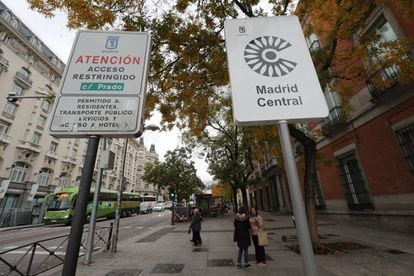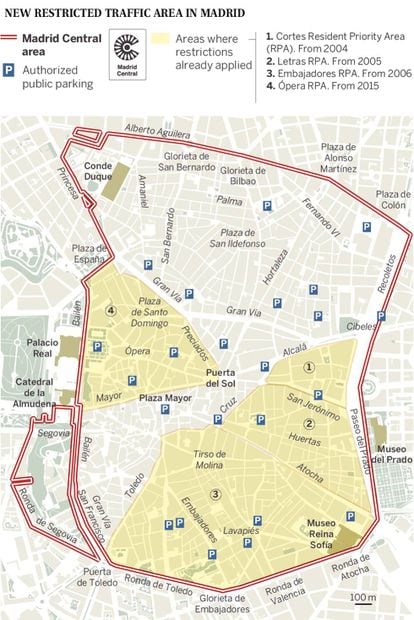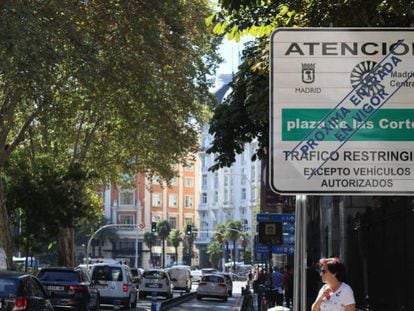Madrid takes historic step to becoming a car-free city center
New measures are in effect to curb air pollution and increase space given over to pedestrians

Madrid on Friday joined a global list of pioneering cities fighting air pollution through local initiatives. In a historic move, the Spanish capital has introduced Madrid Central, a raft of measures aimed at reducing greenhouse gas emissions in the city center. The project is part of a larger move to improve the quality and safety of a space that is shared by cars, motorcycles, pedestrians, bicycles and a growing number of personal mobility devices.
Viewed as a legacy-making project for Mayor Manuela Carmena, of the leftist Ahora Madrid party, Madrid Central has made 472 hectares of the city center off-limits to traffic, except for local residents and public transportation. Non-residents with appropriate energy labels may enter to leave their vehicle in a public parking lot, and exceptions are made for people with reduced mobility, ambulances, taxis, private-hire cars and delivery vans. Electric vehicles will also be allowed into Madrid Centro.
This is a very important moment for the city
Inés Sabanés, Madrid mobility councilor
City officials added that ongoing reforms in several downtown streets will increase space for pedestrians by nearly 22,000 square meters.
In the spirit of favoring sustainable mobility in this crowded space, there are also new rules in effect since October 23 affecting speed limits, approved parking areas for motorcycles, priority for pedestrians and proper use of mobility devices.
City Hall said in a release that during December there will be no action taken against violators, as officials conduct an awareness campaign about the benefits of Madrid Centro. In January there will be automatic controls and notices will be sent out to offenders, although no fines will be issued for the first two months.

Improving the air quality in cities is a EU mandate, and the European Commission has set 2020 as the deadline for Madrid to meet its targets. City officials say that Madrid Central will reduce emissions by 40% as a result of eliminating through traffic and banning the biggest polluters from the area.
Many European cities have taken steps to curb emissions, but only four have gone further than Madrid and introduced fees to access the city center: London, Milan, Stockholm and Gothenburg.
An old project
The initiative is not brand new – it had been proposed by former mayors Alberto Ruiz-Gallardón and Ana Botella, both of the Popular Party (PP).
In the 1950s and 60s, European cities transformed themselves to dedicate most of their public space to cars, building wide avenues and ample parking spaces. In the late 1980s, however, an opposite trend began to take back the cities for pedestrians by eliminating space for private vehicles. Madrid joined this movement, and one of the earliest controversies involved the decision, made by a Socialist administration, to close off Retiro Park to traffic.
Many European cities have taken steps to curb emissions, but only four have gone further than Madrid
The next steps were taken by a PP mayor, Ruiz-Gallardón, who pedestrianized many streets in the downtown area and created the first Resident Priority Zones (APZ) in 2004. These areas, located in the neighborhoods of Cortes, Letras and Embajadores, are restricted and non-residents may only enter to go to a parking lot – the same as Madrid Central.
In 2006, Ruiz-Gallardón attempted to extend these traffic restrictions to an area very similar to today’s Madrid Centro, but he was unable to gain enough support. Ana Botella tried it in 2014, but strong opposition from local business owners made her shelve the plan. Today, the PP is opposed to Madrid Central, which it has appealed before several authorities.
Historic day
“This is a very important moment for the city,” said Inés Sabanés, the local head of environment and mobility issues, who called Friday “a historic day.”
The project has met with fierce opposition from local retailers, transportation professionals and citizens alike, mirroring similar reactions in places like London, where the congestion charge introduced 15 years ago initially drew broad condemnation, which later turned into support. London has reduced traffic in the center by a third, and become a role model for Milan, Stockholm, Gothenburg and Singapore. Officials in New York City are considering it.
English version by Susana Urra.












































